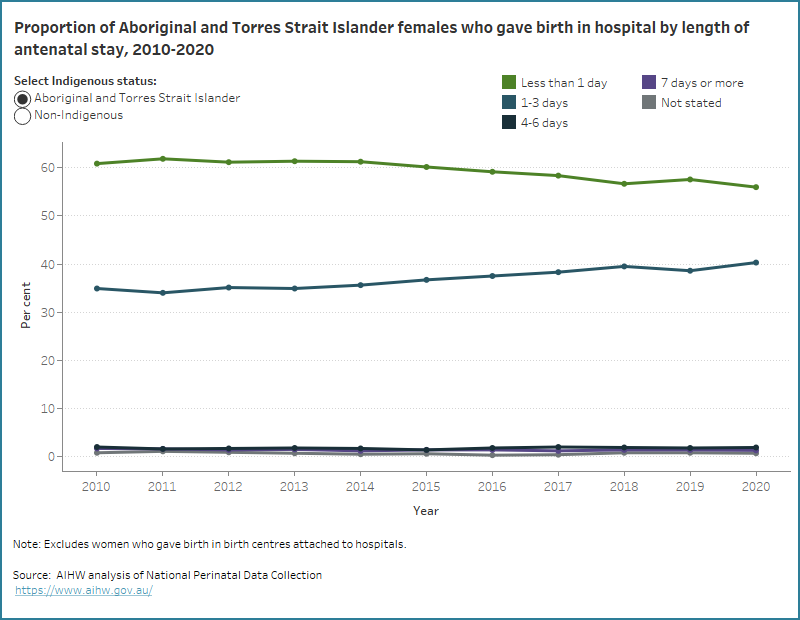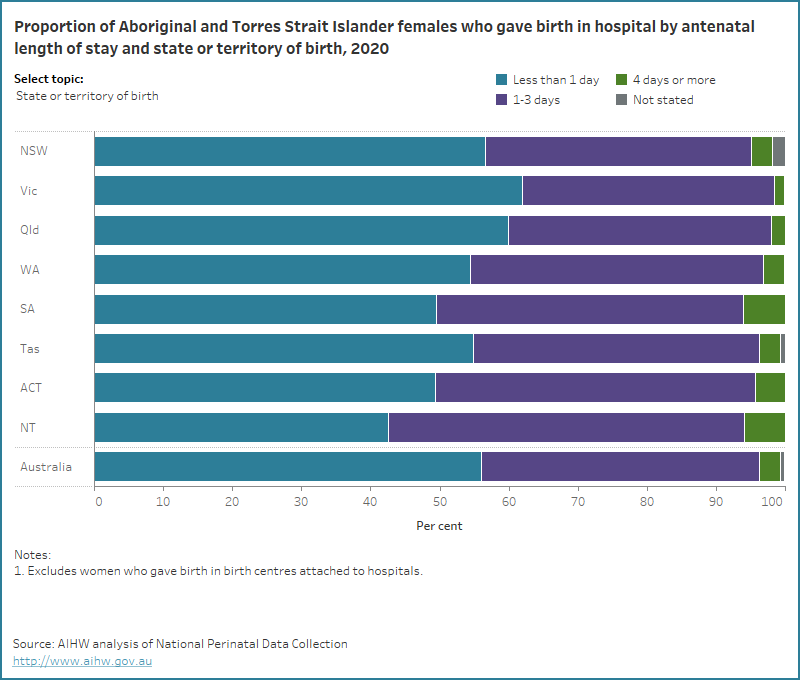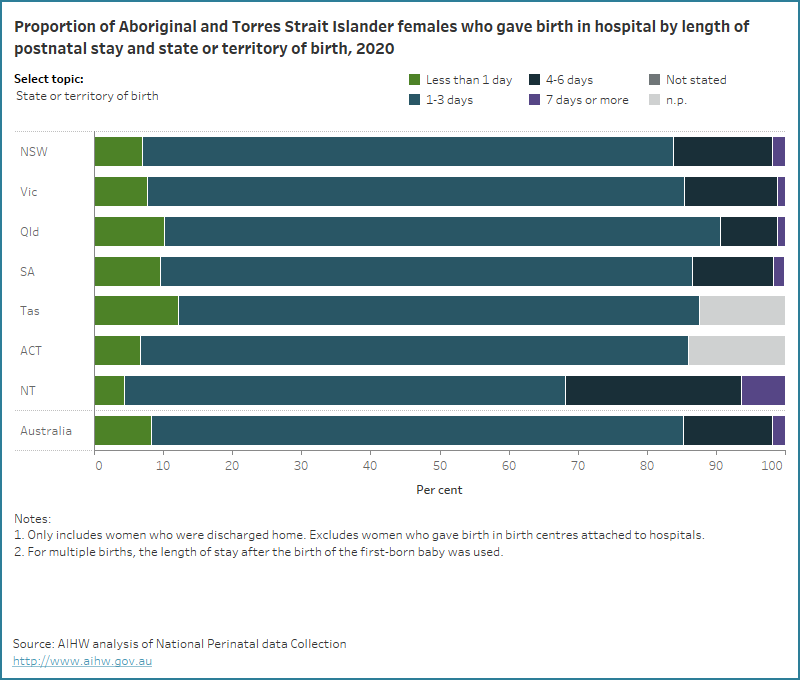 Maternal length of stay in hospital
Maternal length of stay in hospital
On this page:
Antenatal length of stay
Antenatal length of stay refers to the number of days between admission to hospital and the birth event. Data on antenatal length of stay are based on mothers who gave birth in hospitals.
Aboriginal and Torres Strait Islander females who live in remote areas of Australia may have to relocate before giving birth (for more information on routine relocation see Geography). Generally, women who relocate and have low-risk pregnancies travel a few weeks before their due date and stay close to a birthing facility and those with high-risk pregnancies may be asked to travel much earlier in the pregnancy and stay in hospital (AIHW 2017; Barclay 2016).
Due to routine relocation practices, Aboriginal and Torres Strait Islander mothers who live in remote areas may spend weeks away from their family and community, therefore facing a lack of practical and emotional support as well as isolation and increased financial costs (AIHW 2017; Barclay 2016; Department of Health 2020).
In 2020, 56% of Aboriginal and Torres Strait Islander females who gave birth had an antenatal stay of less than 1 day and, 40% had an antenatal stay of 1-3 days, 1.8% had an antenatal stay of 4-6 days and 1.2% had an antenatal stay of 7 days or more (compared with 59%, 35%, 0.7% and 0.6%, respectively, of non-Indigenous females).
Whilst routine relocation may account for some of the longer antenatal lengths of stay for Aboriginal and Torres Strait Islander mothers, this difference may also be due to maternal factors associated with high-risk pregnancies, such as diabetes and obesity.
Between 2010 and 2020 the antenatal length of stay for Aboriginal and Torres Strait Islander mothers has been relatively stable, with 96% of antenatal stays being 3 days or less in both 2010 and 2020 and around 3% of antenatal stays being 4 days or more (3.5% in 2010, compared with 3.0% in 2020). The greatest changes in this period were for antenatal stays of less than 1 day (from 61% in 2010 to 56% in 2020) and 1-3 days (from 35% in 2010 to 40% in 2020).
The data visualisation below shows the proportion of Aboriginal and Torres Strait Islander and non-Indigenous females who gave birth in hospital by grouped antenatal length of stay, from 2010.
Figure 1: Proportion of Aboriginal and Torres Strait Islander females and non-Indigenous females who gave birth in hospital by length of antenatal stay from 2010 to 2020
Line graph of length of antenatal stay by Indigenous status. Most Aboriginal and Torres Strait Islander mothers had an antenatal stay of 3 days or less.

In 2020, Aboriginal and Torres Strait Islander mothers who were more likely to have an antenatal stay of 4 days or more were those who:
- lived in the most disadvantaged areas (3.6%, compared with between 2.2% and 2.6% for other socioeconomic areas)
- lived in Very remote areas (5.3%, compared with between 2.5% and 3.1% for other remoteness areas)
- were aged 40 years and over (8.0%, compared with between 2.4% and 5.1% for other maternal age groups)
- had no labour (6.1%, compared with 3.6% for induced and 1.2% for spontaneous labour)
- had a caesarean section birth (5.3%, compared with 1.5% for instrumental and 1.9% for non-instrumental vaginal birth).
The data visualisation below presents data on grouped antenatal length of stay for Aboriginal and Torres Strait Islander females who gave birth in hospital, by selected maternal characteristics for 2020.
Figure 2: Proportion of Aboriginal and Torres Strait Islander females who gave birth in hospital by antenatal length of stay and selected topic from 2020
Bar chart for antenatal stay by selected topics. 56% of Aboriginal and Torres Strait Islander mothers stayed for less than 1 day.

Postnatal length of stay
Postnatal length of stay refers to the number of days between the birth event and date of discharge or transfer from the hospital where birth occurred, or death. Data on postnatal length of stay are based on mothers who gave birth in hospitals and were discharged to home and exclude data from Western Australia.
A mother’s postnatal length of stay is related to maternal factors, such as recovery after birth particularly for caesarean section birth, management of obstetric and maternal health conditions, management of conditions related to the baby and health system factors such as resourcing pressures (Rayner et al. 2008; Blumenfeld et al. 2015).
The aims of postnatal care in hospital are to provide mothers and their partners and/or family with advice and support around physical recovery, breastfeeding, parenting skills and linking to supports in the community (Rayner et al. 2008).
In one study, Australian mothers – particularly first-time mothers – reported concerns related to confidence in caring for their baby and access to the support of health professionals if their postnatal stay in hospital was deemed to be too short (McLachlan et al. 2009). In a separate study, Aboriginal and Torres Strait Islander mothers reported disappointment in a lack of continuity of care through to the postnatal period (Sivertsen et a. 2020).
In 2020, 8.2% of Aboriginal and Torres Strait Islander females who gave birth had a postnatal stay of less than 1 day, 77% had a postnatal stay of 1-3 days, 13% had a postnatal stay of 4-6 days and 1.9% had a postnatal stay of 7 days or more (compared with 5.2%, 69%, 25% and 1.1% of non-Indigenous females).
Between 2010 and 2020 the postnatal length of stay for Aboriginal and Torres Strait Islander mothers has shortened, with an increase in postnatal stays of 3 days or less (from 75% in 2010 to 85% in 2020) and a decrease in postnatal stays of 4 days or more (from 25% in 2010 to 15% in 2020). There were changes during this period for postnatal stays of less than 1 day (from 5.6% in 2010 to 8.2% in 2020), 1-3 days (from 69% in 2010 to 77% in 2020), 4-6 days (from 21% to 13%) and 7 days or more (from 4.0% in 2010 to 1.9% in 2020).
The data visualisation below shows the proportion of Aboriginal and Torres Strait Islander and non-Indigenous females who gave birth in hospital and were discharged home by grouped postnatal length of stay, from 2010.
Figure 3: Proportion of Aboriginal and Torres Strait Islander females and non-Indigenous females who gave birth in hospital by length of postnatal stay from 2010 to 2020
Line graph of length of postnatal stay by Indigenous status. Most Aboriginal and Torres Strait Islander mothers had a postnatal stay of 3 days or less.
In 2020, Aboriginal and Torres Strait Islander females who gave birth were most likely to have a postnatal stay of 3 days or less if they:
- lived in the second area of socioeconomic disadvantage (87% for quintile 2, compared with between 79% for the least disadvantaged areas (quintile 5) and 85% for the most disadvantaged areas (quintile 1))
- lived in Outer regional areas (89%, compared with between 72% for Very remote areas and 87% for Inner regional areas)
- were aged 20-24 years or 25-29 years (both 87%, compared with 81% for those aged 40 years and over and 84% for those aged under 20 years)
- had a parity of 3 (89%, compared with 80% of first-time mothers and 88% of those with a parity of 1 and 2)
- had spontaneous labour (90%, compared with 86% for induced and 75% for no labour)
- had a non-instrumental vaginal birth (92%, compared with 81% for instrumental vaginal birth and 74% for caesarean section birth)
- gave birth in a public hospital (87%, compared with 50% of those who gave birth in a private hospital).
The data visualisation below presents data on grouped postnatal length of stay for Aboriginal and Torres Strait Islander females who gave birth in hospital and were discharged home, by selected maternal characteristics for 2020.
Figure 4: Proportion of Aboriginal and Torres Strait Islander females who gave birth in hospital by postnatal length of stay and selected topic for 2020
Bar chart for postnatal stay by selected topics. 77% of Aboriginal and Torres Strait Islander mothers stayed for 1 to 3 days.

References
AIHW (Australian Institute of Health and Welfare) (2017) Spatial variation in Aboriginal and Torres Strait Islander women’s access to 4 types of maternal health services, Cat. no. IHW 187 Canberra: AIHW.
Barclay L, Kornelsen J, Longhan J, Robin S, Kruske S, Kildea S, Pilcher J, Martin T, Grzybowski S, Donoghue D, Rolfe M and Morgan G (2016) ‘Reconceptualising risk: perceptions of risk in rural and remote maternity service planning’, Midwifery 38:63–70, doi:10.1016/j.midw.2016.04.007.
Blumenfeld YJ, El-Sayed YY, Lyell DJ, Nelson LM and Butwick AJ (2015). ‘Risk Factors for Prolonged Postpartum Length of Stay Following Cesarean Delivery’, American Journal of Perinatology 32(9), doi:10.1055/s-0034-1543953.
Department of Health and Aged Care (2020) Clinical Practice Guidelines: Pregnancy Care. Canberra: Australian
Government Department of Health and Aged Care.
McLachlan HL, Gold L, Forster DA, Yelland J, Rayner J and Rayner S (2009) ‘Women's views of postnatal care in the context of the increasing pressure on postnatal beds in Australia’, Women and birth 22(4), doi:10.1016/j.wombi.2009.04.003.
Rayner J, Forster D, McLachlan H, Yelland J and Davey M (2008). ‘A state-wide review of hospital postnatal care in Victoria, Australia: The views and experiences of midwives’, BMC Pregnancy and Childbirth 24, doi:10.1016/j.midw.2006.10.008.
Sivertsen N, Anikeeva O, Deverix J and Grant J (2020). ‘Aboriginal and Torres Strait Islander family access to continuity of health care services in the first 1000 days of life: a systematic review of the literature’, BMC Health Services Research 20, doi: 10.1186/s12913-020-05673-w.


